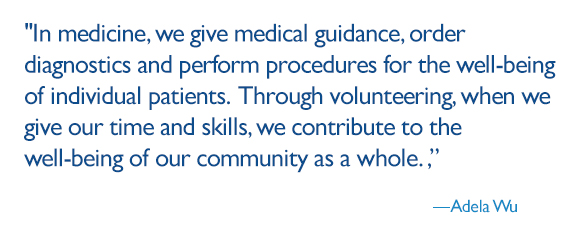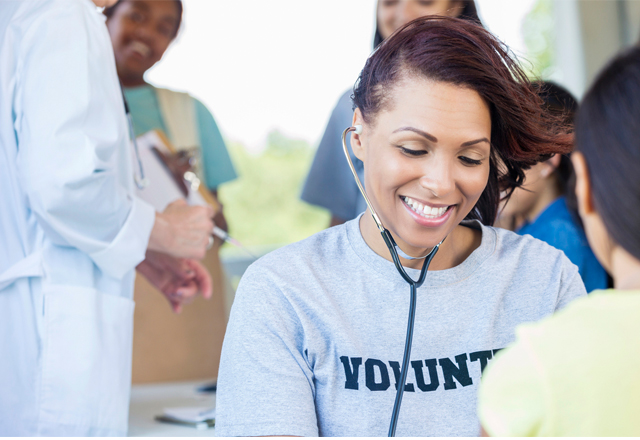Medicine means a lot of things to different people — patient care, research, education, lifelong learning — but to me, one of the most meaningful aspects of my medical training so far has come from my involvement in community service. Community service has given me the opportunity to be a part of Baltimore in a way other than simply as a student. When I volunteer, I no longer observe the city as an outsider. Baltimore becomes more than the location of the school where I study or the hospital where I work.
The sign for Charm City Clinic on Jefferson Street is easy to miss — the building is marked mostly with signage for the Men and Families Center, which hosts the clinic. The clinic is the only student-run, free health clinic in the neighborhood, reaching 3,500 people in the community by 2015. I started as a medical screener during my first year of medical school, collecting patient histories as well as blood pressure and blood glucose measurements. Downstairs, undergraduate volunteers helped set up insurance or residents gave free vision screenings in the busy waiting room.
On a typical Saturday, the clinic serves an average of 40 patients with medical and insurance needs — a remarkable accomplishment, given that the organization is almost entirely run by volunteer screeners, case managers and physicians who graciously donate their time and expertise. I wanted to get even more involved, so I joined the clinic’s auxiliary board, comprising Johns Hopkins medical students and the executive director of the clinic, to lead the fundraising and grants committee during my second year of medical school. Along the way, while helping to take care of patients’ health and raising awareness for the clinic in the city and beyond with applications to local and national foundations, I was able to better understand the state of my Baltimore community through volunteering with the clinic.
Volunteering is also a way for me to share what I care about with others. During my research year, I chose to fill the gaps in my time by tutoring at Commodore John Rogers Elementary School for Reading Partners, a national organization dedicated to raising reading achievement for kids who have fallen below the grade-level standard in low-income elementary schools. This issue is particularly pertinent in Baltimore, given that nearly 89 percent of children are not reading at grade level by the fourth grade and 61 percent of low-income children have no books to read at home. I remember hearing these statistics and feeling compelled to help, as literacy is a cause specifically dear to me. My love for reading was cemented during elementary school, when the local public library was unabashedly my favorite destination to hang out at on the Saturday mornings when my father had off from work.

Now, I donate an hour each week to revisit and read my childhood classics and favorites, from Dr. Seuss to Roald Dahl, with my student. After I attended orientation and completed a background check, the Reading Partners program assigned a student I would tutor during my preferred block of time during the week. Each elementary school student has two Reading Partners sessions per week, so different tutors work with the same student on a unified curriculum designed by the program.
Through the Johns Hopkins Student Outreach and Resource Center (SOURCE) and the annual campus activities fair, I have also spent time tutoring at a local elementary school, Wolfe Street Academy, for the past two years. Many of my classmates have used SOURCE to find a number of similarly rewarding experiences volunteering with diverse programs, including the Incentive Mentoring Program, Student Sight Savers Program and Community Adolescent Sex Education. Regardless of the volunteer organization, community service encapsulates many of the values that are inherent and fundamental to medicine — namely, providing care to the individual as a means to better the community. In medicine, we give medical guidance, order diagnostics and perform procedures for the well-being of individual patients. Through volunteering, when we give our time and skills, we contribute to the well-being of our community as a whole.
References
- Charm City Clinic. Charm City Clinic 2015 Annual Report. https://charmcityclinic.files.wordpress.com/2016/09/cccannualreport2015workingupdated-docx2.pdf.
- Reading Partners. The Literacy Challenge. http://readingpartners.org/the-literacy-challenge/
Related Content
- Learn more about opportunities to volunteer in your Baltimore community.
- School of medicine graduate students reaping the mutual benefits that come from engaging with the public about science.
